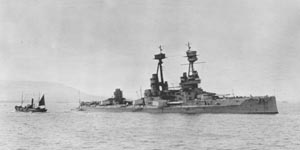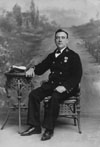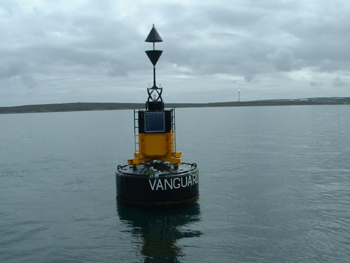
HMS Vanguard, shortly after completion
Postcard courtesy of Jonathan Saunders
(click on each photo for an enlargement)
Just before midnight on Monday, 9 July, 1917, the St Vincent class battleship HMS Vanguard suddenly blew up, taking over 800 of her crew down with her. It was a magazine explosion in one of the two magazines which served the amidships turrets 'P' and 'Q'. She was a veteran of Jutland: an account by her Surgeon may be read by clicking here.
A definitive reason for the cause of the cordite explosion has never been found. The possiblities:
Of the three, sabotage is the least likely: no agency or individual has ever claimed responsiblity; there has never been any evidence turn up in support of the theory; and just as important is the fact that when she was lost, Vanguard was one of the least modern ships in the Grand Fleet. The security measures for her were no different than for the more recent arrivals in Scap Flow. It stands to reason that any 'agent' with the ability to destroy a Royal Navy capital ship would choose one of the more powerful ones.
Instead, the most likely cause was the second: a fire in an adjacent compartment (coal bunker or patent fuel space) which smoldered away undetected, long enough for some cordite near the adjoining bulkhead to overheat to dangerous levels.

Vanguard at sea, shortly before her loss

Vanguard in Scapa Flow
(her list has nothing to do with the explosion, but will have been some sort of drill)
Both photographs courtesy of the Orkney Library Photo Archive - click to enlarge
One eyewitness account, that of Charles William Mynott a signalman in HMS Marlborough would report:
I was on watch on HMS Marlborough between 8pm and midnight [in] 1917 or 1918 and was facing HMS Vanguard and saw her start to explode, 1st aft 2 midships 3 foc'sle and then one huge explosion. I woke the Signal Boatswain who was asleep on the Bridge.
Following is an extract from a notebook maintained by Able Seaman Ernest "Mick" Moroney who witnessed the Vanguard explosion when on watch duty aboard HMAS Melbourne at Scapa Flow, 9th July 1917. Courtesy of Paul Moroney of Australia.
"HMS Vanguard Battleship blown up in Scarpa Flo Hbr all hands lost, spectator 9 July 17. 2 saved.
HMS VANGUARD Scarpa Flow North Scotland at 11.20 pm on the 9 th July a great explosion occurred in the midst of the Grand Fleet, a terrible detonation took place lighting the whole fleet as if it were daylight there was a crash and one of the big boats went sky high with a crew of 900 men all searchlights were switched on immediately but not a thing was to be seen.
A trawler which was close by got smothered in blood and pieces of human flesh, and afterwards picked up half the body of a marine the only body recovered up to date. I happened to be on watch and saw nearly everything no one knows how she went up, but seeing she had a new ships company it is surmised that it was the work of German spies (Later) 2 men saved 1 Marine and 1 AB I Officer died immediately after. 187 men recovered from the sea."
This photo of "Mick" Moroney is inscribed on the rear: "Bill & Mick at Bombala 1919." Bill,
in army uniform, was Mick's
younger brother. Bombala is on the south coast of New South Wales, Australia.

Ernest attested for the Royal Australian Navy at the age of 15 on 1st June 1912, and was one of the first 37 naval cadets to serve n the Australian Naval Cadet Training Ship HMAS TINGIRA at Sydney. Later he joined the Australian Flagship Cruiser HMAS MELBOURNE, which in November 1914 participated in the first Australian troop convoy to the United Kingdom. It was from this convoy that Captain Silver of the MELBOURNE dispatched their sister ship HMAS SYDNEY to search and destroy the German raider SMS EMDEN. The ensuing battle remains the most celebrated event in Australian Naval history.
At the time of the Armistice in November 1918 Ernest was serving in Constantinople. He later transferred to submarines and retired as a Petty Officer.
Further reading:
William Schleihauf, "Disaster in Harbour: The Loss of
HMS Vanguard" in The Northern Mariner / le Marin du Nord,
Volume X, Number 3 (July 2000) - the journal of
the Canadian Nautical Research Society.
The Report of the Court of Enquiry may be read by clicking here.
Jonathan Saunders notes that:
I just looked at Lt. Cdr A.C.H. Duke's CWGC memorial. He was buried at Lyness RN Cemetary and the CWGC does not list another memorial, so on that basis 823 men plus the 22 buried at Lyness (and not recorded on the other three memorials must have died), if you use the Portsmouth Register.
The "sponsor" of this page is Jonathan Saunders (jcs_gfc@hotmail.com), who has supplied several of the photographs, from postcards in his collection. Jonathan would appreciate hearing from anyone also interested in the ship and her crew, or who have additional illustrations and ephemera. It is dedicated to all the men lost in Vanguard, and to the memory of
Chief Yeoman of Signals, 169907 Oscar Charlton Cox, RN.

Jonathan's Great Grandfather.

Chief Stoker Alfred Henry Tidmarsh, 143647
Brian Tidmarsh (Brian.Tidmarsh@btinternet.com) has contributed these photographs and notes regarding his relative, lost in Vanguard. The photograph above "was framed as a memorial which was given to each of the four children by his second wife Violet."
 Alfred Tidmarsh, while in Malta |
 Scroll of Commemoration |
|
 letter notifying next of kin |
 he is buried in Lyness |

Benjamin Barnes RN, courtesy of Bill Chesters
Bill Chesters has been kind enough to send the following...
Immediately after the loss of the Vanguard the Royal Navy sent divers to the wreck to recover bodies, sensitive material and gather evidence that would help explain the explosion. Benjamin Barnes of HMS Imperieuse was part of that diving team.
The irony could not have been lost on Ben Barnes as his first ship in August 1913, had been HMS Natal that suffered a similar fate to the Vanguard when she was destroyed by internal explosion in 1915. However by 1915 Ben was no longer with the Natal but involved in the Dardanelles campaign and had his own scrape with death. Ben survived being shot by a Turkish sniper and his grandson, Bill Chesters, still has the small calibre bullet and hurt certificate in his possession. Ben Barnes was all the more fortunate as the bullet had to be removed from his neck.
Following hospitalisation at Malta, Ben returned home and fate led him to the Vanguard. It is unfortunate that like so many of his ilk, Ben Barnes spoke infrequently, if at all, of his more horrific experiences from the Great War but he did tell his family that when the diving team recovered the bodies of Vanguard men they were instructed to bring them up to the surface face first. The bodies were heavy and this was not an easy process to perform, but never the less was strictly enforced by the officers. This must have irked Ben as this was one of the few stories he recounted many times.
Ben Barnes died in 1963. On his mantle-piece the day he died was an old wooden clock with a brass mounting engraved with the words "Salvaged from HMS Vanguard, blown up July 9th 1917". From some of the salvaged teak the Carpenter of the Imperieuse had made three clocks, one for the Captain, one for himself, and one he gave Benjamin Barnes.

An unknown crewman, courtesy of Gerald Southam (gsoutham@sprint.ca)
Stand still! Stand Still! Ye leaping waves
And mourn along with me
For a gallant ship has crossed the bar
Of the great eternal sea:
A flash, a roar, a blood red flame,
Then a huge overwhelming cloud,
And a thousand soles are wrapped within
The ocean's winding shroud.
Ten thousand doors do ever lead
To death upon the deep:
Sometimes they open silently
Sometimes our hearts do creep
When a blinding flash, and a deafening crash
Sends a good ship to her doom
And her gallant crew are hid from view
Within a watery tomb.
Oh! Little we know of the price men pay
Who guard the silvery sea,
Who keep our homes inviolate
Each town, each winding lea;
We reckon it up in paltry cash
In bars of gleaming gold
But the ransom's dyed in a ruddy tide-
The blood of warriors bold!
So bare your heads ye landsmen all,
Who live at home in ease,
And pray the Lord that ye worthy be
Of the men that hold the seas;
Of the mighty Vanguard who are stood
So valiant in the strife,
Of her gallant crew that flashed from view
Through death to endless life!
From the Chatham News, 24 July 1917, courtesy of Jonathan Saunders.
Christmas Card from 1914

Porthole recovered from the wreck, now in the Lyness Museum

Brian Budge's photo taken from just outside the Control Room on Flotta, looking
north to show the Loading Jetty in the foreground, but visible beyond is
the buoy to mark the wreck of HMS Vanguard, located a cable (200 yards) to
the east of the main wreck section. The buoy is the smaller (right of
photo) of the two objects in front of the Jetty, the larger in mid-photo,
is "Bravo SPM" - one of the two loading buoys out in Scapa Flow. The photo
is centred on the site of Vanguard's wreck.

|

|

One of Vanguard's 12-inch Shells Amidst the Wreckage
(photograph (c) William Schleihauf)
Richard Herrell has been kind enough to contribute photographs of a model of Vanguard, made from pieces of the wreck:



Return to WWI The Maritime War
Return to WWI Archive main page.